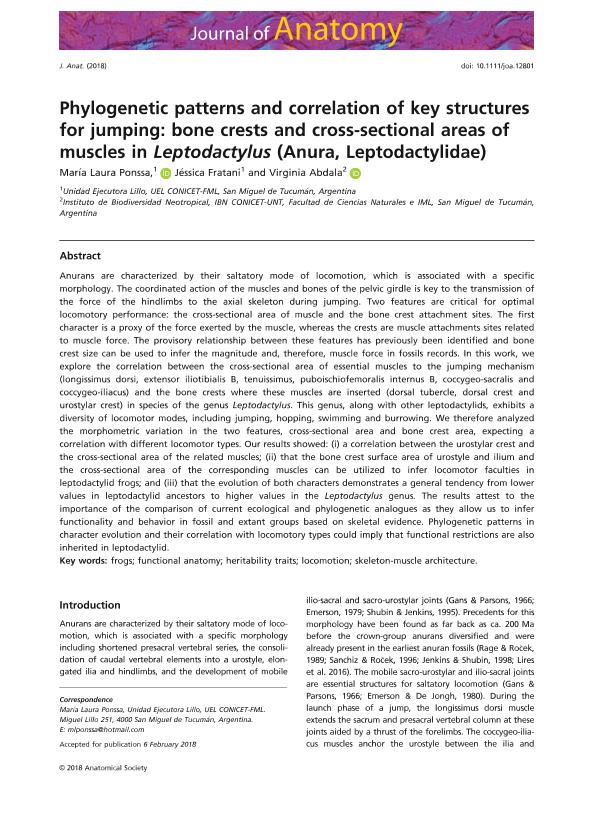Artículo
Phylogenetic patterns and correlation of key structures for jumping: Bone crests and cross-sectional areas of muscles in Leptodactylus (Anura, Leptodactylidae)
Fecha de publicación:
02/2018
Editorial:
Wiley Blackwell Publishing, Inc
Revista:
Journal of Anatomy
ISSN:
0021-8782
Idioma:
Inglés
Tipo de recurso:
Artículo publicado
Clasificación temática:
Resumen
Anurans are characterized by their saltatory mode of locomotion, which is associated with a specific morphology. The coordinated action of the muscles and bones of the pelvic girdle is key to the transmission of the force of the hindlimbs to the axial skeleton during jumping. Two features are critical for optimal locomotory performance: the cross-sectional area of muscle and the bone crest attachment sites. The first character is a proxy of the force exerted by the muscle, whereas the crests are muscle attachments sites related to muscle force. The provisory relationship between these features has previously been identified and bone crest size can be used to infer the magnitude and, therefore, muscle force in fossils records. In this work, we explore the correlation between the cross-sectional area of essential muscles to the jumping mechanism (longissimus dorsi, extensor iliotibialis B, tenuissimus, puboischiofemoralis internus B, coccygeo-sacralis and coccygeo-iliacus) and the bone crests where these muscles are inserted (dorsal tubercle, dorsal crest and urostylar crest) in species of the genus Leptodactylus. This genus, along with other leptodactylids, exhibits a diversity of locomotor modes, including jumping, hopping, swimming and burrowing. We therefore analyzed the morphometric variation in the two features, cross-sectional area and bone crest area, expecting a correlation with different locomotor types. Our results showed: (i) a correlation between the urostylar crest and the cross-sectional area of the related muscles; (ii) that the bone crest surface area of urostyle and ilium and the cross-sectional area of the corresponding muscles can be utilized to infer locomotor faculties in leptodactylid frogs; and (iii) that the evolution of both characters demonstrates a general tendency from lower values in leptodactylid ancestors to higher values in the Leptodactylus genus. The results attest to the importance of the comparison of current ecological and phylogenetic analogues as they allow us to infer functionality and behavior in fossil and extant groups based on skeletal evidence. Phylogenetic patterns in character evolution and their correlation with locomotory types could imply that functional restrictions are also inherited in leptodactylid.
Archivos asociados
Licencia
Identificadores
Colecciones
Articulos(IBN)
Articulos de INSTITUTO DE BIODIVERSIDAD NEOTROPICAL
Articulos de INSTITUTO DE BIODIVERSIDAD NEOTROPICAL
Articulos(UEL)
Articulos de UNIDAD EJECUTORA LILLO
Articulos de UNIDAD EJECUTORA LILLO
Citación
Ponssa, María Laura; Fratani Da Silva, Jéssica; Abdala, Virginia Sara Luz; Phylogenetic patterns and correlation of key structures for jumping: Bone crests and cross-sectional areas of muscles in Leptodactylus (Anura, Leptodactylidae); Wiley Blackwell Publishing, Inc; Journal of Anatomy; 232; 5; 2-2018; 870-885
Compartir
Altmétricas




